The Pennsylvania Railroad, legal name The Pennsylvania Railroad Company also known as the "Pennsy", was an American Class I railroad that was established in 1846 and headquartered in Philadelphia, Pennsylvania. It was named for the commonwealth in which it was established. By 1882, Pennsylvania Railroad had become the largest railroad, the largest transportation enterprise, and the largest corporation in the world. Its budget was second only to the U.S. government.
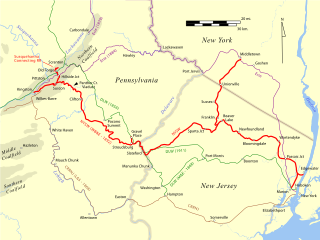
The New Jersey Midland Railway was a 19th-century predecessor to the New York, Susquehanna and Western Railway (NYS&W) that operated in Northern New Jersey and Orange County, New York.
The Junction Railroad was a railroad created in 1860 to connect lines west of downtown Philadelphia, Pennsylvania, and allow north-south traffic through the metropolitan area for the first time. The railroad consisted of 3.56 miles of double track and 5.3 miles of sidings. It owned no locomotives or rolling stock. The line connected the Philadelphia and Reading Rail Road line at the west end of the Columbia Bridge over the Schuylkill River, crossed the Pennsylvania Railroad line, ran parallel to Market Street, and turned south to connect with the Philadelphia, Wilmington and Baltimore Railroad at Gray's Ferry.

The Philadelphia, Wilmington and Baltimore Railroad (PW&B) was an American railroad that operated independently from 1836 to 1881.

The Main Line of Public Works was a package of legislation passed by the Commonwealth of Pennsylvania in 1826 to establish a means of transporting freight between Philadelphia and Pittsburgh. It funded the construction of various long-proposed canal and road projects, mostly in southern Pennsylvania, that became a canal system and later added railroads. Built between 1826 and 1834, it established the Pennsylvania Canal System and the Allegheny Portage Railroad.
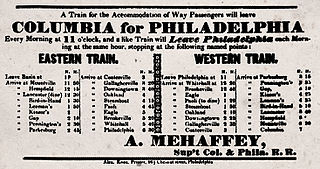
Philadelphia and Columbia Railroad (P&CR) (1834) was one of the earliest commercial railroads in the United States, running 82 miles (132 km) from Philadelphia to Columbia, Pennsylvania, it was built by the Pennsylvania Canal Commission in lieu of a canal from Columbia to Philadelphia; in 1857 it became part of the Pennsylvania Railroad. It is currently owned and operated by Amtrak as its electrified Keystone Corridor. The Philadelphia and Columbia Railroad's western terminus was located near the former ferry site known as Wright's Ferry, in the town once of that name, but now Columbia in Lancaster County. There the P&CR met with the Pennsylvania Canal—navigations and improvements on the Susquehanna River east bank approximately 30 miles (48.3 km) south of Harrisburg, Pennsylvania. Most of its right-of-way was obtained by the actions of the Pennsylvania Canal Commission which operated the railroad under the various enabling acts of the Pennsylvania legislature known as the Main Line of Public Works in support of a far sighted plan to link the whole state by canals. With an engineering study reporting back a finding that obtaining sufficient waters to flood the intended 80+ mile canal from Philadelphia to Columbia, the Canal Commission and legislature authorized the railway on the right of way intended for the canal.

The Keystone Corridor is a 349-mile (562 km) railroad corridor between Philadelphia and Pittsburgh, Pennsylvania, that consists of two rail lines: Amtrak and SEPTA's Philadelphia-to-Harrisburg main line, which hosts SEPTA's Paoli/Thorndale Line commuter rail service, and Amtrak's Keystone and Pennsylvanian inter-city trains; and the Norfolk Southern Pittsburgh Line. The corridor was originally the Main Line of the Pennsylvania Railroad.

The Northern Central Railway (NCRY) was a Class I Railroad connecting Baltimore, Maryland with Sunbury, Pennsylvania, along the Susquehanna River. Completed in 1858, the line came under the control of the Pennsylvania Railroad (PRR) in 1861, when the PRR acquired a controlling interest in the Northern Central's stock to compete with the rival Baltimore and Ohio Railroad (B&O). For eleven decades the Northern Central operated as a subsidiary of the PRR until much of its Maryland trackage was washed out by Hurricane Agnes in 1972, after which most of its operations ceased as the Penn Central declined to repair sections. It is now a fallen flag railway, having come under the control of the later Penn Central, Conrail, and then broken apart and disestablished. The northern part in Pennsylvania is now the York County Heritage Rail Trail which connects to a similar hike/bike trail in Northern Maryland down to Baltimore, named the Torrey C. Brown Rail Trail. Trackage around Baltimore remains in rail service as well as most of the trackage in Pennsylvania which is operated by Norfolk Southern and the southernmost section in Pennsylvania is operated by the Northern Central heritage railway.
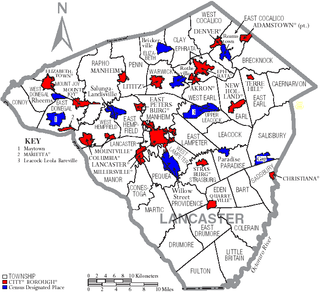
Transportation in Lancaster County, Pennsylvania has a long and variegated history. An early-settled part of the United States, and lying on the route between Philadelphia and Harrisburg, it has been the site of early experiments in canals, railroads, and highways. Before all these, at least ten Native American paths crossed parts of the county, many connecting with the Susquehannock village of Conestoga.

Pennsylvania Route 230 is a 28.4-mile (45.7 km) long state route in central Pennsylvania. Its western terminus is at an intersection with U.S. Route 22 in Harrisburg. Its eastern terminus is at an interchange with PA 283 near Salunga. The route passes northwest-southeast through Dauphin and Lancaster counties and serves as a surface road parallel to the PA 283 freeway that connects the cities of Harrisburg and Lancaster. Along the way, PA 230 passes through Middletown, Elizabethtown, and Mount Joy. The route intersects the Airport Connector near the Harrisburg International Airport, PA 441 and PA 341 in the Middletown area, PA 241 and PA 743 in Elizabethtown, and PA 772 in Mount Joy.

The Harrisburg Subdivision is a railroad line owned by CSX Transportation in the U.S. state of Pennsylvania. The line is located in the city of Philadelphia, connecting Greenwich Yard and the Philadelphia Subdivision with the Trenton Subdivision along a former Pennsylvania Railroad line. Much of the Harrisburg Subdivision is the High Line or West Philadelphia Elevated along 31st Street over the 30th Street Station area.

The Trenton Subdivision is a railroad line owned by CSX Transportation in the U.S. states of Pennsylvania and New Jersey. The line runs from CP PARK in Philadelphia, Pennsylvania, northeast to Port Reading Junction in Manville, New Jersey, along a former Reading Company line.

The Schuylkill Branch was a rail line owned and operated by the former Pennsylvania Railroad (PRR) in the U.S. state of Pennsylvania. The line ran from the Philadelphia to Harrisburg Main Line at 52nd Street in Philadelphia north via Norristown, Reading, and Pottsville to Delano Junction. From Delano Junction, the PRR had trackage rights over the Lehigh Valley Railroad's Hazleton Branch and Tomhicken Branch to Tomhicken, where the PRR's Catawissa Branch began. In conjunction with the Catawissa Branch, Nescopeck Branch, and Wilkes-Barre Branch, the Schuylkill Branch gave the PRR a direct line from Philadelphia to Wilkes-Barre.

The Main Line of the Pennsylvania Railroad was a rail line in Pennsylvania connecting Philadelphia with Pittsburgh via Harrisburg. The rail line was split into two rail lines, and now all of its right-of-way is a cross-state corridor, composed of Amtrak's Philadelphia to Harrisburg Main Line and the Norfolk Southern Railway's Pittsburgh Line.

The Pennsylvania Canal was a complex system of transportation infrastructure improvements including canals, dams, locks, tow paths, aqueducts, and viaducts. The Canal and Works were constructed and assembled over several decades beginning in 1824, the year of the first enabling act and budget items. It should be understood the first use of any railway in North America was the year 1826, so the newspapers and the Pennsylvania Assembly of 1824 applied the term then to the proposed rights of way mainly for the canals of the Main Line of Public Works to be built across the southern part of Pennsylvania.
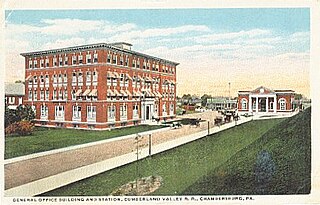
The Cumberland Valley Railroad was an early railroad in Pennsylvania, United States, originally chartered in 1831 to connect with Pennsylvania's Main Line of Public Works. Freight and passenger service in the Cumberland Valley in south central Pennsylvania from near Harrisburg to Chambersburg began in 1837, with service later extended to Hagerstown, Maryland, and then extending into the Shenandoah Valley to Winchester, Virginia. It employed up to 1,800 workers.

The Atglen and Susquehanna Branch is an abandoned branch line of the Pennsylvania Railroad that ran between Lemoyne and Atglen, Pennsylvania. A portion of the line is now the Enola Low Grade Trail.

The Columbia and Port Deposit Railroad (C&PD) was a railroad that operated in Pennsylvania and Maryland in the 19th and early 20th centuries. It operated a 34-mile long (55 km) main line between Columbia, Pennsylvania, and Port Deposit, Maryland, generally along the eastern shore of the Susquehanna River. It later acquired a branch line to Perryville, Maryland. The C&PD was subsequently purchased by the Pennsylvania Railroad (PRR) and, since the 1999 breakup of Conrail, is owned by Norfolk Southern Railway.
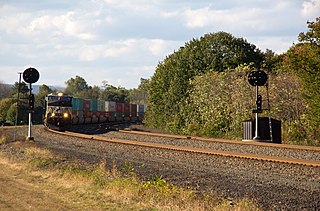
The Pittsburgh Line is the Norfolk Southern Railway's primary east–west artery in its Pittsburgh Division and Harrisburg Division across the U.S. state of Pennsylvania and is part of the Keystone Corridor, Amtrak-Norfolk Southern's combined rail corridor.

















